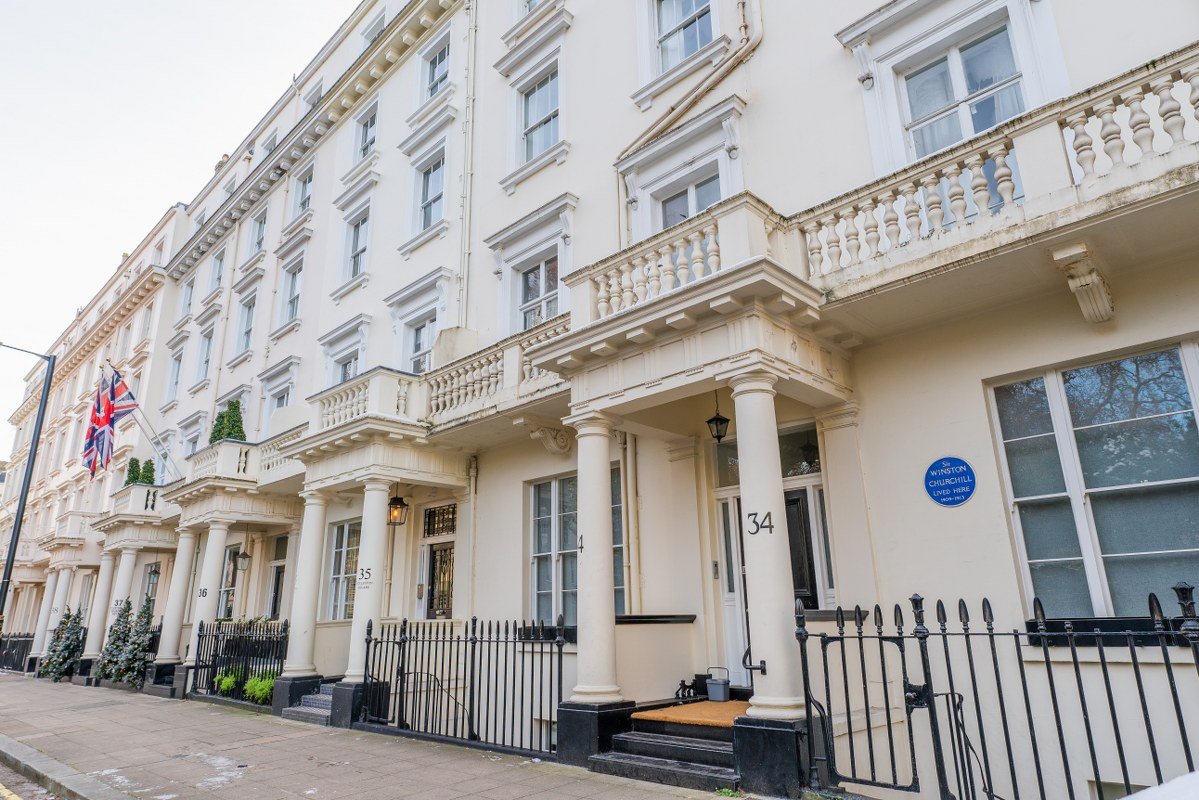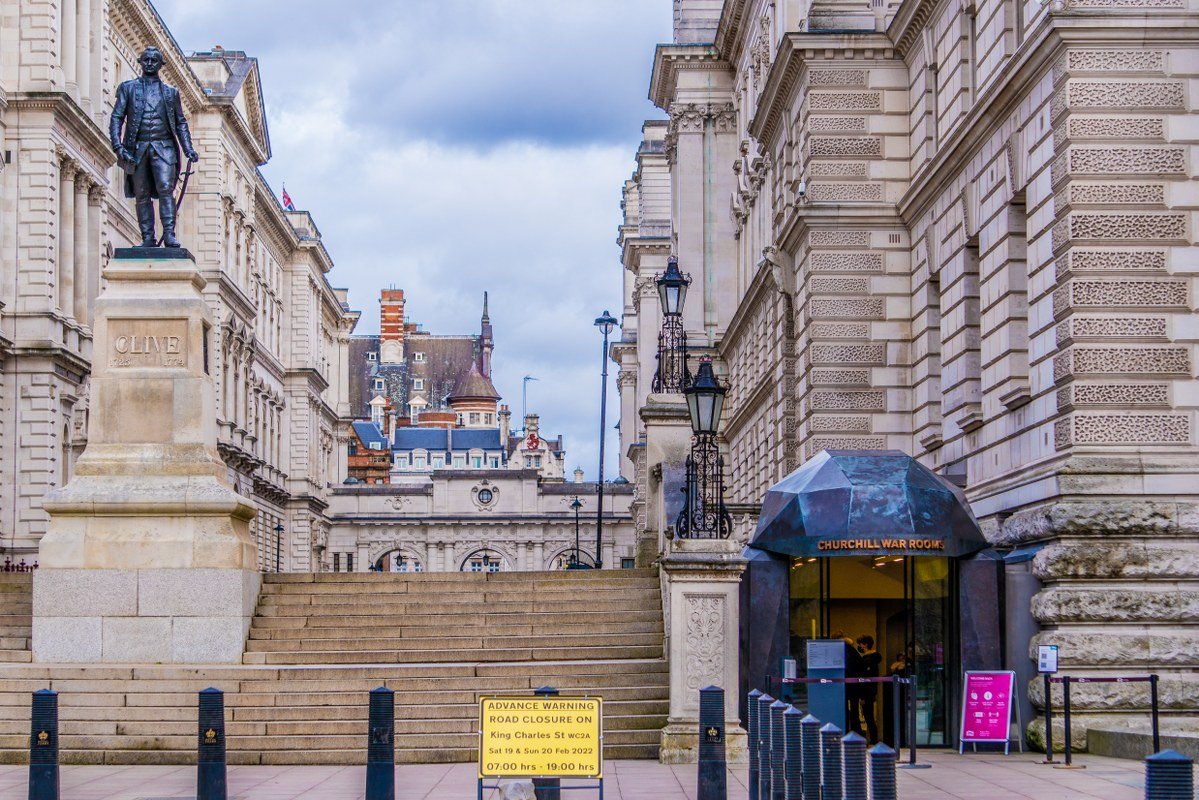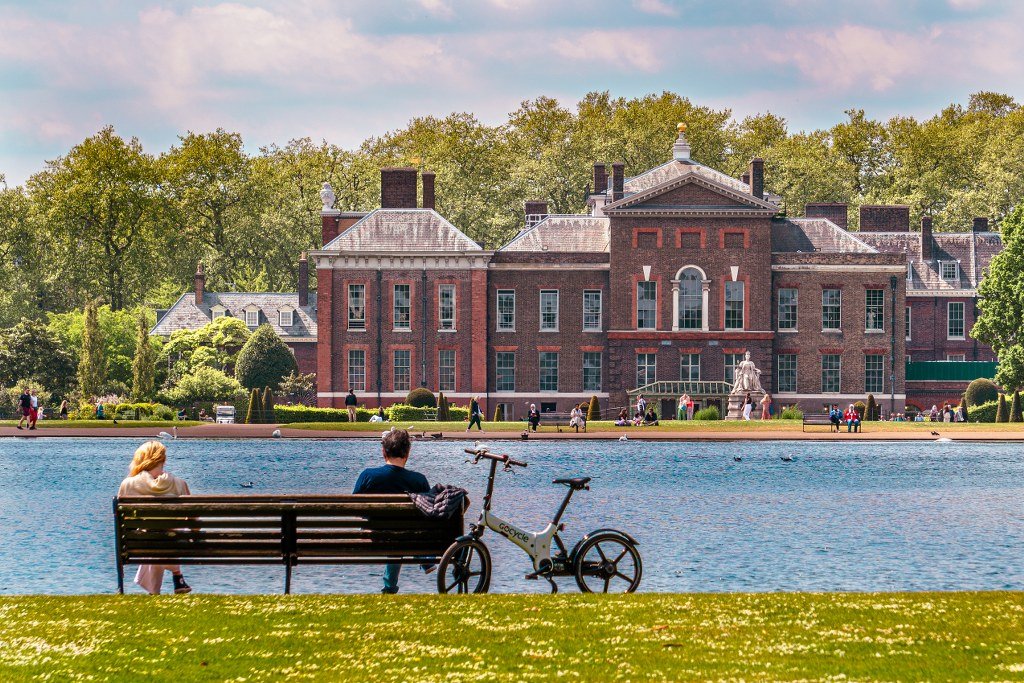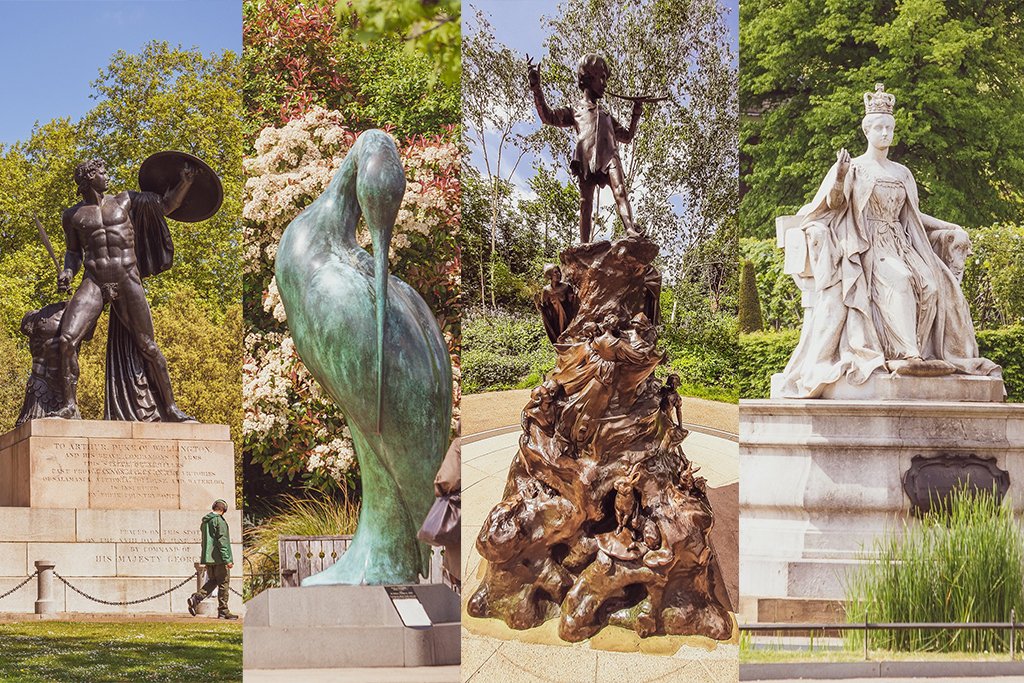Winston Churchill in London: 23 places in London connected to the most famous British Prime Minister
Churchill is best known for being a (twice) British Prime Minister who led Britain to victory in the Second World War.
(Half English, half American) Churchill wasn’t a Londoner by birth.
He was born (to a wealthy, aristocratic family) on November 30, 1874 in Bleinheim Palace, Oxfordshire.
However, his phenomenal lifeline led (on and off) through the streets of London for more than half of a century, and it is rather hard to find another person who had more influence over the fate of this city than Churchill.
“I see into the future, I shall save London and England from the disaster”
Winston Churchill at the age of 16
You will find below a description of 23 places in London associated with this important historical figure (the sites are listed below in order of appearance in Churchill's life).
See my self-guided Winston Churchill London Walking Tour (with a map and a photo gallery!) to find out how to visit 16 of these places described below in just over 2 hours.
See also: self-guided walk around Westminster - the area of London central to Churchill's career as a politician.
Enjoy the read!
CHURCHILL IN LONDON
Harrow School
When we think about Winston Churchill today, we usually think about the older, hunched man who led Great Britain as a Prime Minister.
But obviously, he was once a small child as well.
One of the places in London associated with a young Winston Churchill is the prestigious Harrow School, located in Harrow on the Hill.
He spent here four and a half years of his life - from the age of 13 to 18.
Harrow School is one of the oldest independent boarding schools for boys in the UK (established in 1572!) and one that educated 3 Nobel Prize winners and 7 British Prime Ministers. Churchill was both of the above. He was (twice) a British Prime Minister and received the Nobel Prize in Literature in 1953!
But…Churchill did not like school!
He recall his time at school as “the worst time” of his life.
“I was happy as a child with my toys in my nursery. I have been happier every year since I became a man. But this interlude of school makes a sombre grey patch upon the chart of my journey (…); a time of discomfort, restriction and purposeless monotony”
W. Churchill, My Early Life
Churchill, not being very academic, ended up in an Army class.
“I was not clever enough to go to the Bar” (to became a lawyer)
“I could learn quickly enough the things that mattered”
W. Churchill, My Early Life
Despite his aversion to school, Churchill came to this school as an adult on various occasions.
Including one on October 29th, 1941 (in the middle of WWII), to listen to the traditional Harrow songs, which he was particularly fond of.
During this occasion, one of the songs had been altered by students. The additional verse had been added in Churchill’s honor.
"Not less we praise in darker days
The leader of our nation,
And Churchill's name shall win acclaim
From each new generation.
For you have power in danger's hour
Our freedom to defend, Sir!
Though long the fight we know that right
Will triumph in the end, Sir!"
During this visit, he addressed Harrow students with a speech, which is considered one of his best.
“we must learn to be equally good at what is short and sharp and what is long and tough.”
“You cannot tell from appearances how things will go. Sometimes imagination makes things out far worse than they are; yet without imagination not much can be done. ”
“never give in, never give in, never, never, never, never-in nothing, great or small, large or petty”
“These are not dark days; these are great days — the greatest days our country has ever lived; and we must all thank God that we have been allowed, each of us according to our stations, to play a part in making these days memorable in the history of our race.”
W.Churchill, on October 29, 1941
Harrow School is not in central London (it takes around an hour to get there from Trafalgar Square) and you can see the school only from the High Street.
However, Harrow on the Hill is a very charming part of London, and walking its streets is a real pleasure.
2. Knightsbridge Barracks
Churchill’s training at Harrow School aimed to prepare him for the Royal Military College in Sandhurst (located outside London) and to become a cavalry soldier - that he did achieve.
“I was now on the military career. This orientation was entirely due to my collection of soldiers. I had ultimately nearly fifteen hundred.”
“… the toy soldiers turned the current of my life”
W. Churchill, My Early Life
Churchill entered the Royal Military College in Sandhurst at the age of 18.
During his time at Sandhurst, he took an additional course of riding at Knightsbridge Barracks in London with the Royal Horse Guards, located near Hyde Park.
Churchill did enjoy horse riding.
“I think I was pretty well trained to sit and manage a horse. This is one of the most important things in the world.”
“No hour of life is lost that is spent in the saddle.”
“Taken at a gallop is a very good death to die”
W. Churchill, My Early Life
In 1895, after his graduation (and losing his father a month after the graduation), he gained permission to be a war journalist and keenly injected himself into the first war zones of his life.
He left London and went to Cuba, India, and Sudan.
Click here to see the photo of a 21 years old Churchill in the military uniform of the 4th Queen's Own Hussars in 1895.
3. Churchill’s first flat in London - 105 Mount Street (Mayfair)
After his return to London, at the turn of centuries (in 1900), he launched his political career and moved to the flat at 105 Mount Street, Mayfair.
The second-floor flat at 105 Mount Street became his home.
It was his first “bachelor pad” in London and a place to entertain political friends and family.
He lived here when he was first elected to the Houses of Parliament as a Conservative candidate (at the age of 25).
He moved out of this address in 1905.
Green Park, Marble Arch, Hyde Park Corner, and Bond Street are equally good transport links to get to this place.
It is a 10 min walk from each of these London Underground stations.
There is no blue plaque indicating the historical significance of this place. However, Churchill’s former apartment is easy to find as it is located directly above the cigar shop!
The shop was established here only in 1976 (long after Churchill's death). If you like cigars, you will enjoy visiting this place too.
Churchill loved cigars: he smoked between eight to ten a day!
4. Churchill’s first house in London - 12 Bolton Street
In 1905 Churchill moved to the red brick house at 12 Bolton Street.
This larger accommodation served as his home until 1909. He lived here when he married his wife, Clementine, on September 12th, 1908.
Winston and Clementine had a long and loving marriage. It lasted 56 years.
“My most brilliant achievement was my ability to be able to persuade my wife to marry me.”
Winston Churchill
Churchill’s first house in London is located a 2 min walk from Green Park station.
5. The church where Churchill got married - St Margaret's Church
St Margaret's Church is a 500 years old church located in the heart of Westminster (it is a close neighbor to Westminster Abbey).
Churchill married his wife Clementine here. But he was not particularly fond of the wedding ceremony.
“What a relief to have got that ceremony over!”
W. Churchill
Churchill visited this place also 37 years later, on the 8th of May 1945, on the so-called VE (Victory in Europe) day.
After his speech to the nation announcing the end of the long war, he came for a victory thanksgiving service here to celebrate this important occasion.
6. Churchill’s house where his family grew for the first time - 34 Eccleston Square
In 1909 Churchill and his wife moved to 34 Eccleston Square.
Here Churchill welcomed to this world his first child, daughter Diana (in 1909), and two years later, a son, Randolph (in 1911). He lived here until 1913. And later for two years between 1916-1918.
The house is easy to find as it is marked with a blue plaque honoring his stay here.
This house is located only a few min walk from Victoria Station (rail and tube). Pimlico and Sloane Square tube stations are also suitable transport links for a visit to this place.
7. Churchill’s home as the First Lord of the Admiralty - Admiralty House (1913-15, 1939-40)
In 1911, Churchill was appointed the First Lord of the Admiralty, and two years later (in 1913), he moved with his family to a beautiful building adjacent to the Horse Guards Parade called Admiralty House.
Here, Churchill’s family grew again. In 1914, his daughter Sarah was born. Churchill left the Admiralty House in 1915 but briefly moved back to this address 24 years later, in 1939.
8. 1 Dean Trench Street
Between 1919-1920 Churchill lived close to Parliament at the address 1 Dean Trench Street.
After that, he moved to 2 Sussex Square (1920-24), another location close to Hyde Park. However, there is nothing to see at this location as the former Churchill home at this address was destroyed during WWII.
9. Old War Office
Old War Office (OWO) is a majestic building opposite the Horse Guards at Whitehall.
It was built in 1906. The government used it for military administration until 1964.
Churchill worked here as a Secretary of State for War for two years (1919-21).
The site had a bad reputation as a workspace.
Its poor internal design made it almost impossible to find any particular office - the building at that time had around 1,100 rooms and two miles of corridors!
Interesting fact: The Old War Office inspired Ian Fleming to write the James Bond series! Fleming frequently visited this place as a liaison officer between the War Office and Britain’s Naval Intelligence Service. The OWO was featured in several of the Bond movies.
10. Churchill’s home as a Chancellor of the Exchequer -11 Downing Street (1924-1929)
In 1924 Churchill, for the first time, moved to Downing Street. For now, it was only no 11 - in the official residence of Britain's Chancellor of the Exchequer.
Churchill became Chancellor on 6 November 1924.
He stayed here until 1929.
No 11 Downing Street is located behind some of the most secure gates in London. You can only see it from a distance and through the gates located on the Whitehall or Horse Guards Road.
11. Churchill’s house and a place where he heard the announcement of the beginning of war with Germany- 11 Morpeth Mansions
The red brick apartment block of 11 Morpeth Terrace served Churchill as a base from 1930 to 1939.
He occupied the top two floors of this building.
It was here when he listened (with his wife) to the Chamberlain’s broadcast announcing the declaration of war on Germany.
The building is located only steps away from Victoria Station and is marked with the brown, circular plaque.
12. Churchill’s home as a Prime Minister - 10 Downing Street
In 1940, at the age of 65 and his family fully formulated, he became a Prime Minister for the first time and 10 Downing Street became his official residence. He lived here until 1945. And later, during his second term between 1951 and 1955.
13. Churchill War Rooms
During WWII, London (and the Whitehall) was a target of the German Air Force. The safest way for the government would have been to manage the war efforts from outside London. However, there would have been bad for Londoner's morale.
Therefore the King and the Parliament decided to stay in London.
The New Public Office building (located not far from 10 Downing Street) became the center of all war decisions and a workplace for Churchill.
The (secured with reinforced concrete slabs up to three meters thick) top secret complex was named the Cabinet War Rooms.
In its basement, the leading government ministers, military strategists, and Prime Minister Winston Churchill were deciding the fate of London (and the whole of the UK) during WWII.
When the war ended, the so-called Churchill War Rooms were shut and later turned into a museum.
Churchill War Rooms is a must-see (paid) attraction in London for anyone who likes history. It is a real chance to get a glimpse of what life was like during these dark days (and nights) of the Second World War for Churchill and the people who worked with him.
14. Buckingham Palace
Buckingham Palace is a very symbolic place in Churchill’s history.
As a British Prime Minister, he met here regularly, first with King George VI and later with Queen Elizabeth II.
The PM usually meets the monarch every Wednesday at Buckingham Palace.
But most importantly, on the 8th of May 1945 (the day after Germany signed unconditional surrender), Churchill joined the King and his family on the balcony of Buckingham Palace to celebrate the end of WWII.
The iconic moment he shared not only with the Royal Family but also with thousands of Londoners gathered outside the Palace.
15. House when Churchill died - 28 Hyde Park Gate
The house at 28 Hyde Park Gate is the location where Churchill lived the longest (between 1945-1965, with a 4-year break for 10 Downing Street during his second term as a Prime Minister).
He also died here, on the 24th of January 1965, at the age of 90 (he suffered his final* stroke 12 days earlier).
*Churchill, throughout his life, experienced around 10 strokes, but the majority of them were minor.
He died on the seventieth anniversary of his father's death.
"I'm so bored with it all."
The last words of Winston Churchill
Churchill’s residency in this place is honored with blue plague.
You can find the last house of Churchill on a charming street called Hyde Park Gate, on the south side of Hyde Park. The nearest tube stations are Gloucester Road and South Kensington.
"Operation Hope Not"
In 1953, after one of Churchill's earliest strokes, Queen Elizabeth II decided that his funeral should be "on a scale befitting his position in history”. She ordered the state funeral to be prepared. The plan for Churchill's state funeral was given a code name "Operation Hope Not".
16. Palace of Westminster
Churchill was a great parliamentarian, and the building of the Parliament was his “playground” throughout his professional life.
After he died, his coffin lay in state for three days in Westminster Hall (part of the Palace).
17. St. Paul’s Cathedral
St. Paul’s Cathedral is one of the most recognizable sights in London.
During WW2, Churchill believed that the survival of this building would boost Londoner's morale, and he ordered the protection of the Cathedral at all costs.
The photo of St. Paul's Cathedral taken during one of the heavy german air - raids during WW2 (so-called The Second Great Fire of London) became the most famous photograph of the war.
Although severely damaged during the war, St. Paul's Cathedral managed to survive.
And in 1965, it was chosen for the funeral ceremony of Winston Churchill.
18. Tower of London
After the funeral ceremony at St.Paul’s Cathedral, Churchill’s coffin was carried along the streets of London to the Tower of London.
It is here 90 salutes were fired - one for each year of Churchill’s life.
19. Waterloo Station
Churchill, as a young man, frequently used Waterloo Station to travel to Sandhurst (he even used once the Waterloo Cemetery Line!).
Waterloo was also Churchill’s last stop in London. From the Tower of London, his coffin was transported by river to Waterloo Station. Later it went by train to Bladon.
Churchill wished to be buried at St Martin’s in Bladon, just outside Blenheim Palace grounds (the place where he was born).
20. The grave of Mrs. Elizabeth Everest, a woman who raised Winston Churchill
“ I was a child of the Victorian era”
W. Churchill, My Early Life
Churchill, like most people born and raised in his epoch, had distanced (“refrigerator” type) parents.
“My mother made the same briliant impresion upon my childhood’s eye. She shone for me like the Evening Star. I love her dearly - but at a distance.”
W. Churchill, My Early Life
His parents sent him to boarding school when he was 7 (he saw them once a year!). And he did not like this arrangement!
“I was perfectly hopeless. Irresistible tides drew me swiftly forward. I was no more consulted about leaving home than I had been about coming into the world.”
W. Churchill, My Early Life
Away from bitten London tourist tracks, in the City of London Cemetery and Crematorium in Newham, you can find a grave of a woman who (practically) raised Winston Churchill.
It is a grave of his nanny, Elizabeth Everest, to whom he stayed close throughout his adult life. After she died, Churchill paid for her headstone and provided finances to maintain her grave for many years.
On Everest’s grave, to this day, you can see the words:“by Winston Spencer Churchill, Jack Spencer Churchill" (Jack Spencer Churchill was the youngest brother of Winston)
City of London Cemetery & Crematorium is a well-maintained cemetery located not far from Manor Park Station (served by Elizabeth Line). If you decide to make a trip to it, please note that this cemetery is usually open from 9 am to 4:30 pm.
21. Statue of Winston Churchill in Parliament Square
The best known depiction of Churchill in London is his sculpture prominently located in Parliament Square.
The statue is overlooking the Palace of Westminster.
It was unveiled to the public by his wife Clementine in 1973.
Churchill chosen the location of this statue himself, 25 years earlier!
22. “Allies”
Another statue of Winston Churchill you can find on New Bond Street.
He is depicted there with Franklin D. Roosevelt - the president of the United States.
Both men are sitting on the bench, smiling while holding cigars.*
Both of these men died from strokes!
This sculpture (by Lawrence Holofcener) is called Allies and was erected in 1995.
23. The Churchill Arms (pub!)
The Churchill Arms is one of the most recognizable pubs in London.
It is also the best choice of a pub for a Churchill-themed London walk.
The pub was built in 1750 and was frequently visited by Churchill's grandparents - the 7th Duke of Marlborough and Lady Frances Anne Emily Vane. However, it was given its current name only after WW2.
The pub claims a tight connection to Churchill himself as well. Considering that he was known for being keen on drinking and lived for 20 years within walking distance from the pub, might be some truth to that!
Inside the pub, you will find plenty of Churchill's memorabilia…
…and a Thai restaurant!
Apart from its undeniable connection to Churchill, this pub is also famous for its extensive floral installations throughout the year and extravagant Christmas displays.
The Churchill Arms pub is closing my list of 23 Churchill places in London.
YOU MAY ALSO FIND USEFUL
Below you will find affiliate links. If you decide to make a purchase using one of these links it means I may earn a small commission at no extra cost to you.
INTERESTING READ
If you interested in reading more about Winston Churchill, I can recommend you a biography written by Andrew Roberts titled Walking with Destiny. It is a great read for anyone who is interested in this iconic historical figure.
In this post, you have seen a few quotes from Churchill himself. Mainly taken from his book My Early Life. It is a personal account of his life between 1874-1908 with a detailed description of his first experiences in the war zones.
Did you enjoy this post?
You can find more posts related to London on my blog London By An - including some self-guided walks around hidden gems in London.
YOU MAY ALSO LIKE
Hi EXPLORERS!
I am a compulsive Walker and Story Seeker (and I like a good map!). Check out one of my self-guided WALKS of London (packed with STORIES and MAPS!) and tell me if walking in London is not FUN!?

























































